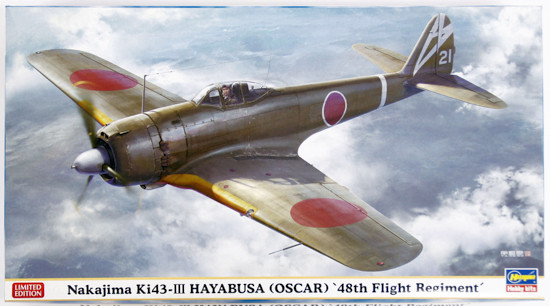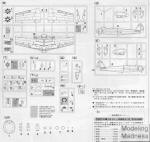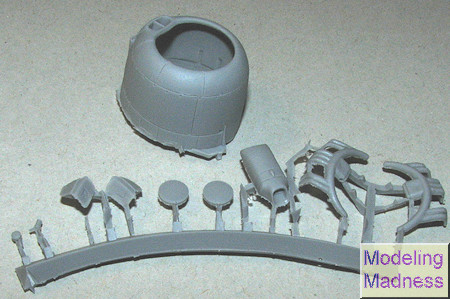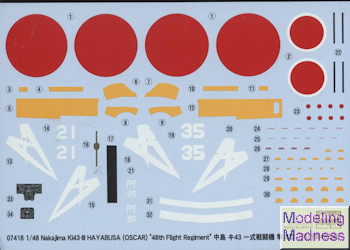
Hasegawa 1/48 Ki-43-III Hayabusa '48th Flight Regiment'
| KIT #: | 07418 |
| PRICE: | 3200 yen (about $27.00) at www.hlj.com |
| DECALS: | Two options |
| REVIEWER: | Scott Van Aken |
| NOTES: | Limited Edition |

| HISTORY |
The Nakajima Ki-43 Hayabusa (隼, "Peregrine Falcon") was a single-engine land-based tactical fighter used by the Imperial Japanese Army Air Force in World War II. The Army designation was "Army Type 1 Fighter" (一式戦闘機); the Allied reporting name was "Oscar", but it was often called the "Army Zero" by American pilots for its side-view resemblance to the Mitsubishi A6M Zero that was flown by the Japanese Navy, using essentially the same radial engine as the Army's Oscar, and with the Oscar having much less framing for its all-around vision canopy than the Zero used.
Like the Mitsubishi-produced A6M Zero, the radial-engined Ki-43 was light and easy to fly and became legendary for its combat performance in East Asia in the early years of the war. It could outmaneuver any opponent, but did not have armor or self-sealing tanks, and its armament was poor until its final version, which was produced as late as 1945. Allied pilots often reported that the nimble Ki-43s were difficult targets but burned easily or broke apart with few hits. In spite of its drawbacks, the Ki-43 shot down more Allied aircraft than any other Japanese fighter and almost all the JAAF's aces achieved most of their kills in it.
The final version of the Ki-43 was the Ki-43-III which utilized the more powerful Nakajima Army Type 1 Ha-115-II engine. Maximum speed increased to 358 mph. This variant was produced until the end of the war, though it did not see the widespread use of the earlier versions and did not offer much additional in the way of pilot protection or heavier armament, something the Hayabusa lacked throughout its production career.
Total production amounted to 5,919 aircraft. Many of these were used during the last months of the war for kamikaze missions against the American fleet.
| THE KIT |
 The
Ki-43 was one of Hasegawa's initial forays into their new tool program of 1/48
Japanese aircraft kits and still remains the best one available in this scale in
terms of fidelity and ease of construction. Of course, it wouldn't be Hasegawa
unless the molds were developed to cover a variety of different variants.
However, the vast majority of those kits have been either the -I or -II
versions. To do the later -III, Hasegawa has had to resort to using resin parts.
I am not sure why they simply did not tool a new cowling with the requisite
exhaust and other bits to do a proper -III as it certainly does not seem to be
all that much. However, resin is the way they have chosen to go.
The
Ki-43 was one of Hasegawa's initial forays into their new tool program of 1/48
Japanese aircraft kits and still remains the best one available in this scale in
terms of fidelity and ease of construction. Of course, it wouldn't be Hasegawa
unless the molds were developed to cover a variety of different variants.
However, the vast majority of those kits have been either the -I or -II
versions. To do the later -III, Hasegawa has had to resort to using resin parts.
I am not sure why they simply did not tool a new cowling with the requisite
exhaust and other bits to do a proper -III as it certainly does not seem to be
all that much. However, resin is the way they have chosen to go.
 Let me start
with that aspect of the kit. There is a separate bag in with most of the base
kit, and this bag includes a new resin cowling and a sprue of resin parts. In
amongst those are a new head rest, new exhaust pipes, inserts for the fuselage
opening behind the cowling, new oil cooler intake, new wheel hubs and a number
of other bits. The resin itself is free of air pockets, but on the cowling the
surface feels rough. The pour stubs are rather large considering how small some
of the parts are. It certainly isn't up to the quality of say, Ultracast and
these bits will take some care in cleaning up.
Let me start
with that aspect of the kit. There is a separate bag in with most of the base
kit, and this bag includes a new resin cowling and a sprue of resin parts. In
amongst those are a new head rest, new exhaust pipes, inserts for the fuselage
opening behind the cowling, new oil cooler intake, new wheel hubs and a number
of other bits. The resin itself is free of air pockets, but on the cowling the
surface feels rough. The pour stubs are rather large considering how small some
of the parts are. It certainly isn't up to the quality of say, Ultracast and
these bits will take some care in cleaning up.
The rest of the kit is standard with a nicely done cockpit, a well molded engine, separate wing tips, a pair of drop tanks for under the wings, and a two piece windscreen/canopy so you can pose the canopy open. Also included are the butterfly flaps, though these can only be built in the deployed position, something that was very rare when on the ground. I've ended up sanding these very thin and gluing them in the closed position as this was more the norm.
 Instructions
are well done with the usual Gunze paint references. As the boxing is for the
48th Flight Regiment, both options are for this unit, differing only in the
thickness of the tail marking, the number and the white band around the rear
fuselage. Both are listed as an olive drab over grey-green. It is quite probable
that the underside of these planes was unpainted, so you may wish to keep that
in mind. The decal sheet includes stencils, instrument decals, a wing walk decal
as well as prop markings and the yellow wing ID markings. I would paint the
latter, especially if you are like me and can never get these decals to look
right after application. As you can see, the white is actually white so these
decals are as good as any aftermarket sheet.
Instructions
are well done with the usual Gunze paint references. As the boxing is for the
48th Flight Regiment, both options are for this unit, differing only in the
thickness of the tail marking, the number and the white band around the rear
fuselage. Both are listed as an olive drab over grey-green. It is quite probable
that the underside of these planes was unpainted, so you may wish to keep that
in mind. The decal sheet includes stencils, instrument decals, a wing walk decal
as well as prop markings and the yellow wing ID markings. I would paint the
latter, especially if you are like me and can never get these decals to look
right after application. As you can see, the white is actually white so these
decals are as good as any aftermarket sheet.
| CONCLUSIONS |
Prior to this kit, the only options for this variant were the old Otaki kit, and the relatively recent Fine Molds kit. While the latter is not a bad kit, this one is just that much better. If you want to add the -III Hayabusa to your collection, then this is the kit you should seek before it sells out (and it will do so rather quickly).
| REFERENCES |
https://en.wikipedia.org/wiki/Nakajima_Ki-43
January 2016
Copyright ModelingMadness.com Thanks to Hobby Link Japan
for the review kit. You can find this kit
at this link. If you would like your product reviewed fairly and fairly quickly, please
contact
the editor or see other details in the
Note to
Contributors.